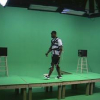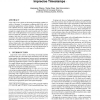112 search results - page 7 / 23 » Recognizing Temporal Trajectories Using the Condensation Alg... |
ICCV
1998
IEEE
14 years 10 months ago
1998
IEEE
Existing object tracking algorithms generally use some form of local optimisation, assuming that an object's position and shape change smoothly over time. In some situations ...
CVPR
2001
IEEE
14 years 10 months ago
2001
IEEE
This paper demonstrates gait recognition using only the trajectories of lower body joint angles projected into the walking plane. For this work, we begin with the position of 3D m...
ICCV
2009
IEEE
15 years 1 months ago
2009
IEEE
This paper introduces an algorithm for detecting walking
motion using point trajectories in video sequences. Given
a number of point trajectories, we identify those which are
sp...
PVLDB
2010
13 years 7 months ago
2010
Large-scale event systems are becoming increasingly popular in a variety of domains. Event pattern evaluation plays a key role in monitoring applications in these domains. Existin...
PAMI
2002
13 years 8 months ago
2002
We advance new active object recognition algorithms that classify rigid objects and estimate their pose from intensity images. Our algorithms automatically detect if the class or p...


